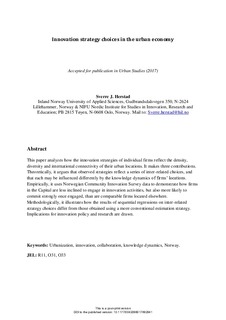Innovation strategy choices in the urban economy
| dc.contributor.author | Herstad, Sverre | |
| dc.date.accessioned | 2017-12-14T15:13:52Z | |
| dc.date.available | 2017-12-14T15:13:52Z | |
| dc.date.created | 2017-03-01T10:25:24Z | |
| dc.date.issued | 2017 | |
| dc.identifier.issn | 0042-0980 | |
| dc.identifier.uri | http://hdl.handle.net/11250/2471979 | |
| dc.description.abstract | This paper analyses how the innovation strategies of individual firms reflect the density, diversity and international connectivity of their urban locations. It makes three contributions. Theoretically, it argues that observed strategies reflect a series of inter-related choices, and that each may be influenced differently by the knowledge dynamics of firms’ locations. Empirically, it uses Norwegian Community Innovation Survey data to demonstrate how firms in the Capital are less inclined to engage in innovation activities, but also more likely to commit strongly once engaged, than are comparable firms located elsewhere. Methodologically, it illustrates how the results of sequential regressions on inter-related strategy choices differ from those obtained using a more conventional estimation strategy. Implications for innovation policy and research are drawn. | nb_NO |
| dc.language.iso | eng | nb_NO |
| dc.subject | Collaboration | nb_NO |
| dc.subject | Innovation | nb_NO |
| dc.subject | Knowledge dynamics | nb_NO |
| dc.subject | Norway | nb_NO |
| dc.subject | Urbanisation | nb_NO |
| dc.title | Innovation strategy choices in the urban economy | nb_NO |
| dc.type | Journal article | nb_NO |
| dc.type | Peer reviewed | nb_NO |
| dc.description.version | acceptedVersion | nb_NO |
| dc.source.pagenumber | 32 | nb_NO |
| dc.source.journal | Urban Studies | nb_NO |
| dc.identifier.doi | https://doi.org/10.1177/0042098017692941 | |
| dc.identifier.cristin | 1454901 | |
| cristin.unitcode | 7463,0,0,0 | |
| cristin.unitname | NIFU Nordisk institutt for studier av innovasjon, forskning og utdanning | |
| cristin.ispublished | true | |
| cristin.fulltext | postprint | |
| cristin.qualitycode | 2 |
Tilhørende fil(er)
Denne innførselen finnes i følgende samling(er)
-
4 - Academic Publications / Vitenskapelige publikasjoner [312]
Academic Articles and Book Chapters -
Publikasjoner fra Cristin [344]
